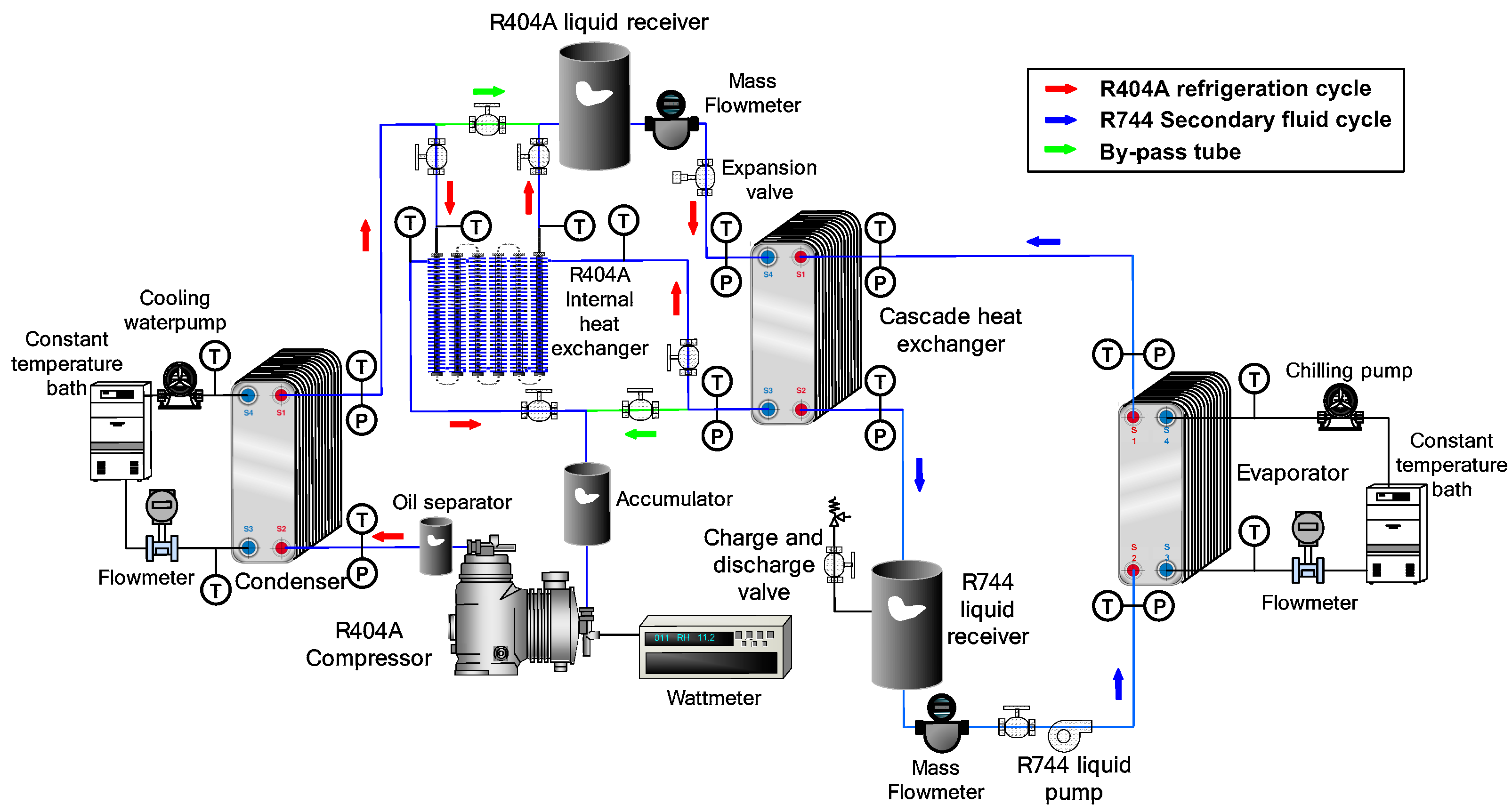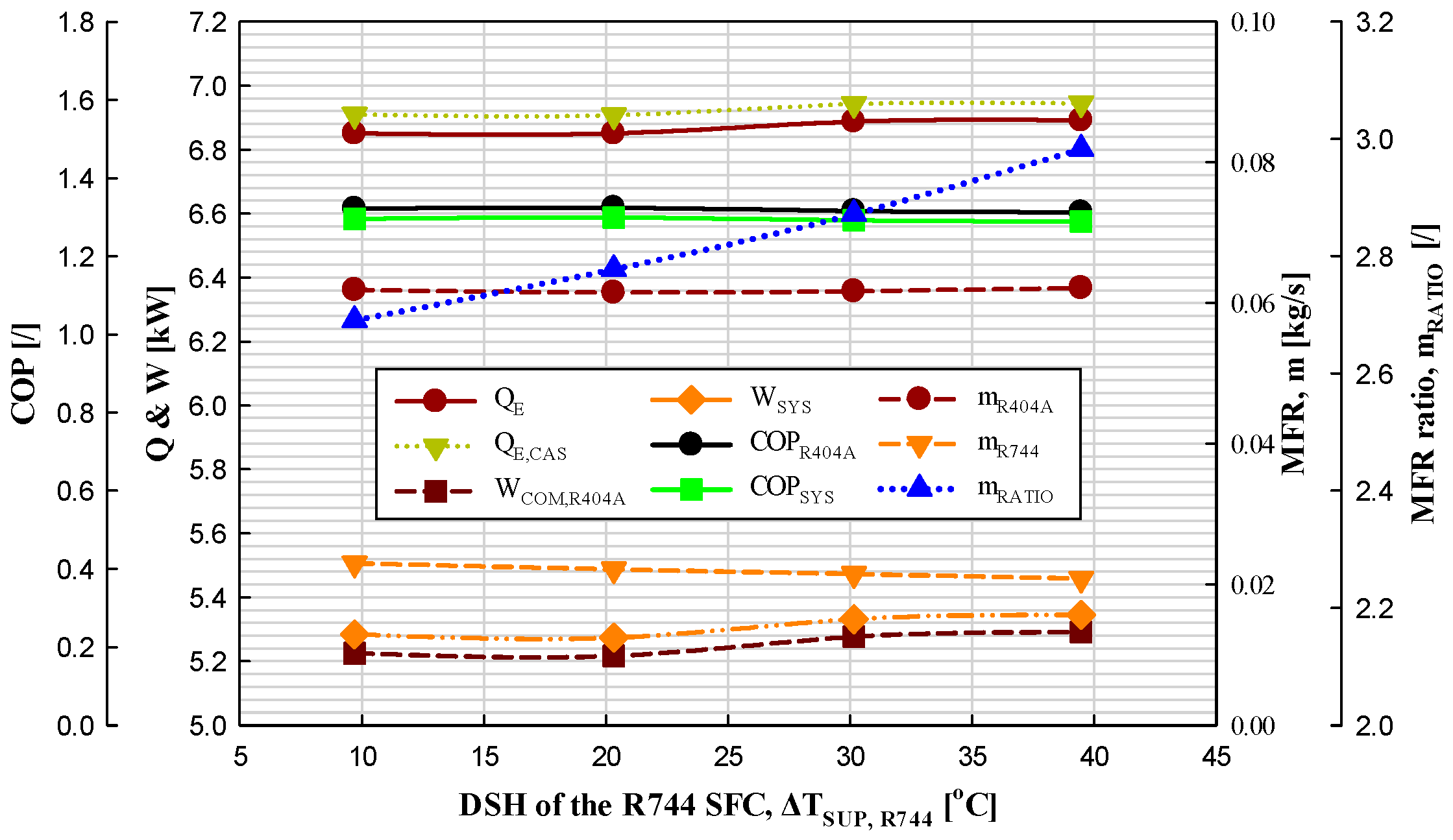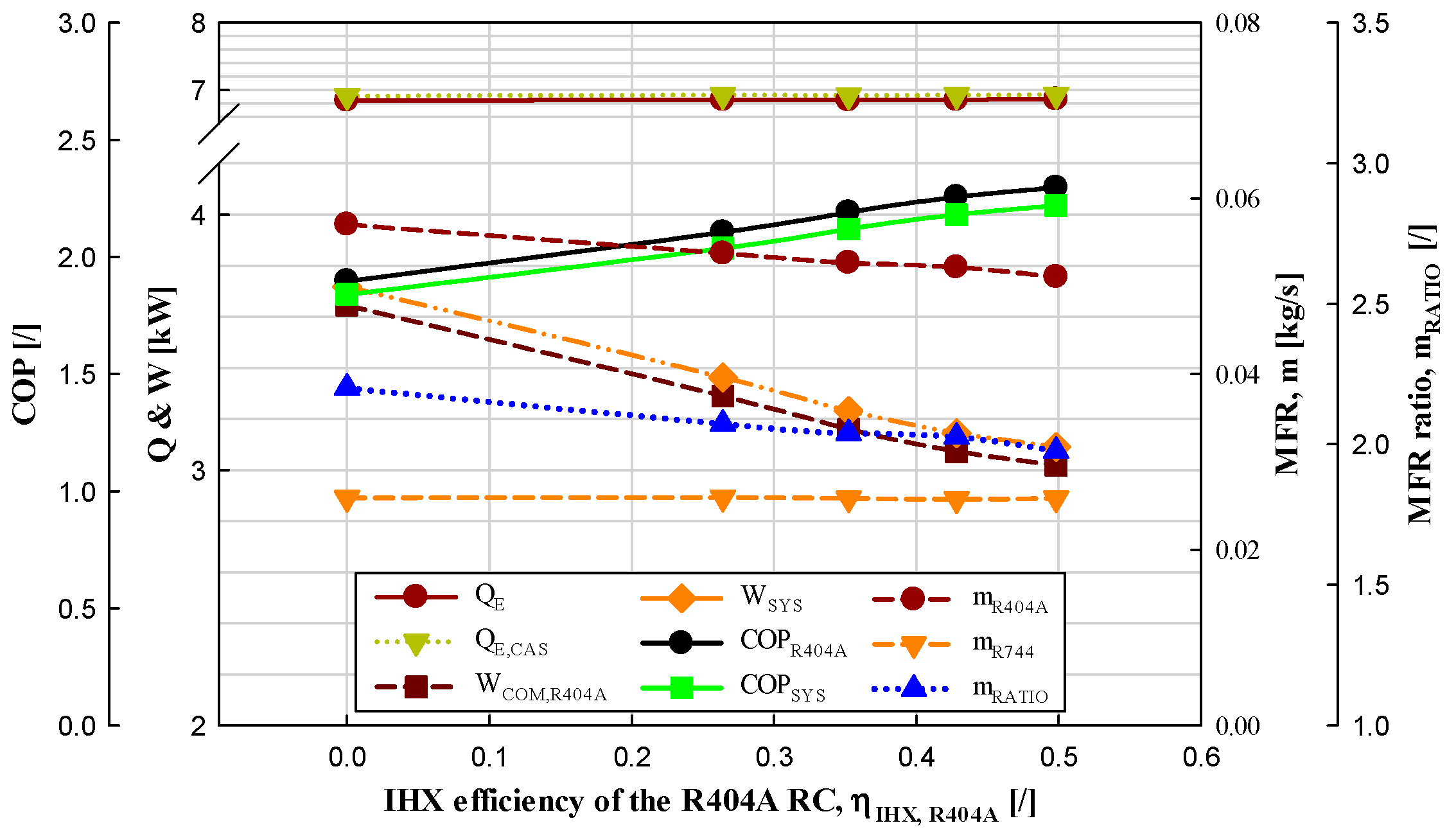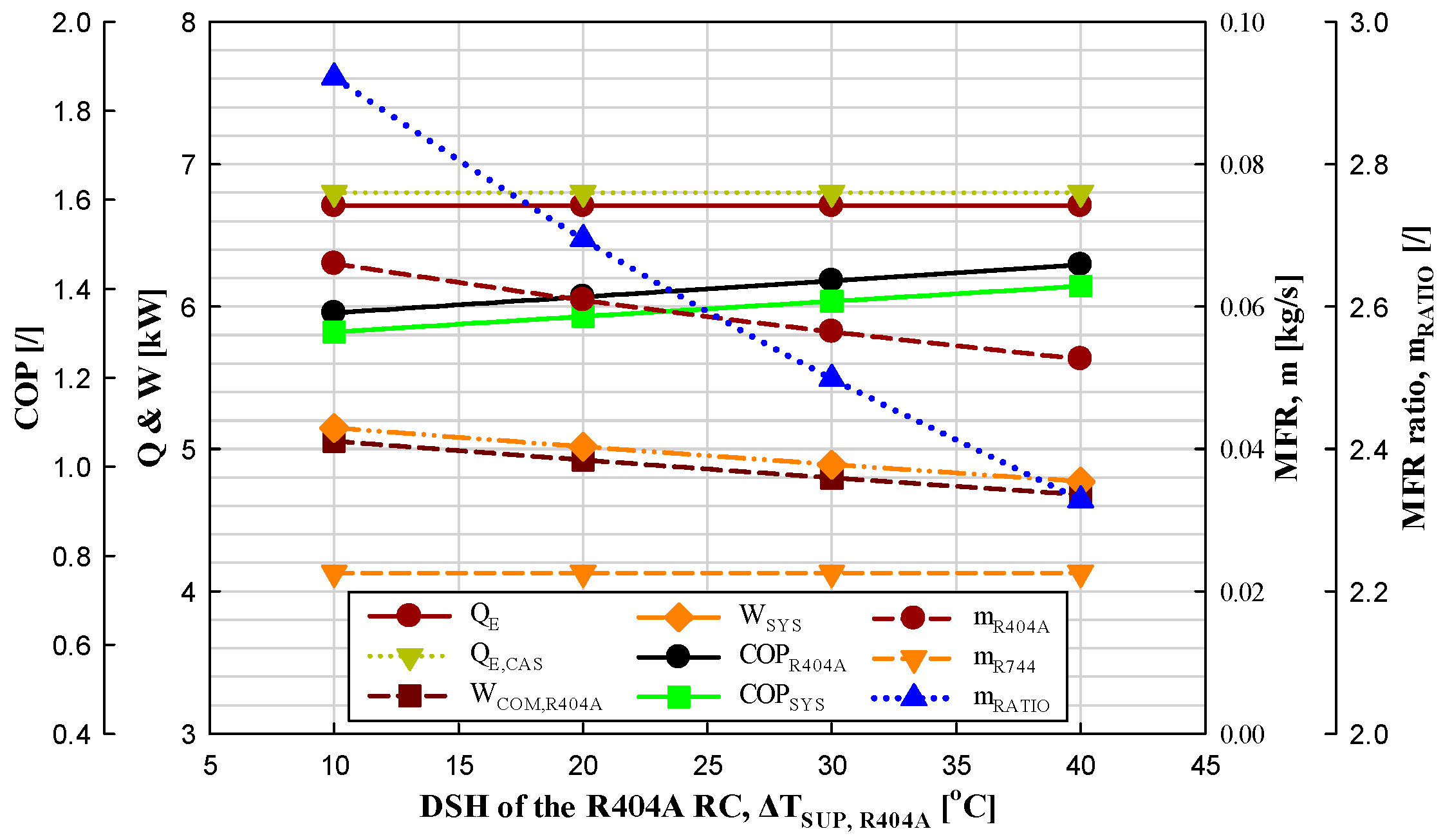Experimental Investigation of R404A Indirect Refrigeration System Applied Internal Heat Exchanger: Part 1—Coefficient of Performance Characteristics
Abstract
1. Introduction
2. Test Device and Data Analysis
2.1. Test Device
2.2. Test Methodoloy
- The cooling-water and heat-source water temperatures of the constant-temperature baths were adjusted to the required temperature.
- The compressor was turned on, and the compressor–inverter frequency and EV were adjusted to establish the MFR and evaporation temperature at the R404A RC.
- After running the R404A RC, the condition of the liquid refrigerant obtained from the R744 receiver was examined, and then the pump was operated.
- The subcooling and superheating degrees of the system were set by adjusting the R744 and cooling-water flow rates.
2.3. Data Analysis and Uncertainties
3. Results
3.1. Influence on DSH
3.1.1. Influence on DSH at the R404A RC
3.1.2. Influence on DSH at the R744 SFC
3.2. Influence on DSC
Influence on DSC at the R404A RC
3.3. Influence on Condensation Temperature
3.4. Influence on Cascade Evaporation Temperature
3.5. Influence on IHX Efficiency
3.6. Comparing Results from Experimental Data and Performance Analysis Data
4. Conclusions
- (1)
- By maximizing the DSH, DSC, CET, and IHX efficiency of R404A RC and reducing the DSH and condensation temperature of R744 SFC to the minimum, the COP of R404A RC and IRS can be improved and the refrigerant charge of R404A can be reduced.
- (2)
- Among the six variables, the change in DSH of R744 SFC has a very minimal effect of less than 1% on the COP and R404A refrigerant charge rate of R404A RC and IRS. Therefore, there is no need to consider R744 SFC when designing R404A IRS using R744 as a secondary fluid.
- (3)
- In terms of COP, CT has the greatest impact, followed by CET, DSH R404A RC, IHX efficiency, DSC of R404A RC, and DSH of R744 SFC.
- (4)
- In terms of refrigerant charge rate reduction, DSH of R404A RC has the greatest impact, followed by DSC of R404A RC, CT, CET, IHX efficiency, and DSH of R744 SFC.
- (5)
- In particular, looking at the trend of the increase in IHX efficiency, the change is very minimal when the efficiency is above 50%, so it is ideal to apply an IHX efficiency of about 50% considering economics, COP, etc.
- (6)
- In the future, the R404A refrigerant must be replaced with other eco-friendly refrigerants. In cases where R404A is to be replaced with other refrigerants, R448A (GWP 1273) and R449A (GWP 1282) are recommended for GWP < 1500, whereas R454C (GWP 148) and R455A (GWP 146) are recommended for GWP < 150 (low-GWP refrigerant).
Author Contributions
Funding
Data Availability Statement
Conflicts of Interest
Nomenclature
| ABBREVIATIONS | |
| CC | Cascade condenser |
| CE | Cascade evaporator |
| CET | Cascade evaporation temperature |
| CHX | Cascade heat exchanger |
| DSC | Degree of subcooling |
| DSH | Degree of superheating |
| DXS | Direct expansion system |
| EHC | Evaporation heat capacity |
| EV | Expansion valve |
| GWP | Global warming potential |
| IE | Inlet enthalpy |
| IHX | Internal heat exchanger |
| IRS | Indirect refrigeration system |
| LT | Low-temperature level |
| MDXS | Multiplexed direct expansion system |
| MFR | Mass flow rate |
| ODP | Ozone depletion potential |
| OE | Outlet enthalpy |
| PCC | Power consumption of compressor |
| RC | Refrigeration cycle |
| SFC | Secondary fluid cycle |
| SYMBOLS | |
| COP | Coefficient of performance (-) |
| h | Enthalpy (kJ/kg) |
| Mass flow rate (kg/s) | |
| Pressure (kPa) | |
| Q | Heat capacity (kW) |
| T | Temperature (°C) |
| W | Power consumption (kW) |
| GREEK SYMBOLS | |
| Difference | |
| Efficiency | |
| SUBSCRIPTS | |
| C | Condensation, Condenser |
| CAS | Cascade heat exchanger |
| COM | Compression |
| E | Evaporation, Evaporator |
| IHX | Internal heat exchanger |
| PUM | Pump |
| Ratio | Ratio |
| R404 | AR404A cycle |
| R744 | R744 cycle |
| SUB | Degree of subcooling |
| SUP | Degree of superheating |
| SYS | Total system |
References
- Choi, S.; Han, U.; Cho, H.; Lee, H. Review: Recent advances in household refrigerator cycle technologies. Appl. Therm. Eng. 2018, 132, 560–574. [Google Scholar] [CrossRef]
- She, X.; Cong, L.; Nie, B.; Leng, G.; Peng, H.; Chen, Y.; Zhang, X.; Wen, T.; Yang, H.; Luo, Y. Energy-efficient and -economic technologies for air conditioning with vapor compression refrigeration: A comprehensive review. Appl. Energy 2018, 232, 157–186. [Google Scholar] [CrossRef]
- Brown, J.S.; Domanski, P.A. Review of alternative cooling technologies. Appl. Therm. Eng. 2014, 64, 252–262. [Google Scholar] [CrossRef]
- Polonara, F.; Kuijpers, L.; Peixoto, R. Potential impacts of the Montreal Protocol Kigali Amendment to the choice of refrigerant alternatives. Int. J. Heat Technol. 2017, 35, S1–S8. [Google Scholar] [CrossRef]
- Heath, E.A. Amendment to the Montreal Protocol on Substances that Deplete the Ozone Layer (Kigali Amendment). Int. Leg. Mater. 2017, 56, 193–205. [Google Scholar] [CrossRef]
- Metz, B.; Kuijpers, L.; Solomon, S.; Andersen, S.O.; Davidson, O.; Pons, J.; de Jager, D.; Kestin, T.; Manning, M.; Meyer, L. IPCC/TEAP; Cambridge University Press: Cambridge, UK, 2005; p. 478. [Google Scholar]
- Queiroz, M.V.A.; Panato, V.H.; Antunes, A.H.P.; Parise, J.A.R.; Bandarra Filho, E.P. Experimental Comparison of a Cascade Refrigeration System Operating with R744/R134a and R744/R404A. In Proceedings of the International Refrigeration and Air-Conditioning Conference, West Lafayette, IN, USA, 11–13 July 2016; Paper 1785. pp. 1–10. Available online: http://docs.lib.purdue.edu/iracc/1785 (accessed on 19 September 2020).
- Wikipedia. Available online: https://en.wikipedia.org/wiki/List_of_refrigerants#cite_note-ASHRAE2007-34m-v-10 (accessed on 25 July 2021).
- Pearson, A. Refrigeration with ammonia. Int. J. Refrig. 2008, 31, 545–551. [Google Scholar] [CrossRef]
- Wang, K.; Eisele, M.; Hwang, Y.; Radermacher, R. Review of secondary loop refrigeration systems. Int. J. Refrig. 2010, 33, 212–234. [Google Scholar] [CrossRef]
- Yee, R.P.; Hermes, C.J.L. A thermodynamic study of water-based nanosuspensions as secondary heat transfer fluids in refrigeration systems. Int. J. Refrig. 2018, 89, 104–111. [Google Scholar] [CrossRef]
- Llopis, R.; Sánchez, D.; Cabello, R. Refrigerants for vapor compression refrigeration systems. In Advances in New Heat Transfer Fluids; CRC Press: Boca Raton, FL, USA, 2017; pp. 463–522. [Google Scholar]
- Schwarz, W.; Gschrey, B.; Leisewitz, A.; Herold, A.; Gores, S.; Papst, I.; Usinger, J.; Oppelt, D.; Croiset, I.; Pedersen, P.H.; et al. Preparatory Study for a Review of Regulation (EC) No. 842/2006 on Certain Fluorinated Greenhouse Gases; Final Report; European Commission: Brussels, Belgium, 2011. [Google Scholar]
- Palm, B. Refrigeration systems with minimum charge of refrigerant. Appl. Therm. Eng. 2007, 27, 1693–1701. [Google Scholar] [CrossRef]
- Melinder, A. Handbook on Indirect Refrigeration and Heat Pump Systems; International Institute of Refrigeration: Paris, France, 2015. [Google Scholar]
- Lugo, R.; Fournaison, L.; Chourot, J.M.; Guilpart, J. An excess function method to model the thermophysical properties of one-phase secondary refrigerants. Int. J. Refrig. 2002, 25, 916–923. [Google Scholar] [CrossRef]
- Melinder, A. Properties of Secondary Working Fluids for Indirect Systems; International Institute of Refrigeration (IIR) Publications: Paris, France, 2010; ISBN 978-2-913149-76-2. [Google Scholar]
- Burri, R. CO2 as a Secondary Refrigerant, an Alternative Technology for Ice Rinks. In Proceedings of the Centenary Conference of the British Institute of Refrigeration, London, UK, 10 November 1999; Available online: https://iifiir.org/en/fridoc/co2-as-a-secondary-refrigerant-an-alternative-technology-for-ice-rinks-19330 (accessed on 16 August 2024).
- Rolfsman, L. CO2 and NH3 in the supermarket IcaFocus. In Proceedings of the IIR Proceedings, Applications for Natural Refrigerants, Aarhus, Denmark, 3–6 September 1996; pp. 219–225. [Google Scholar]
- Nekså, P.; Girotto, S.; Schiefloe, P.A. Commercial refrigeration using CO2 as refrigerant system design and some experimental results. In Proceedings of the Natural Working Fluids ’98, IIR-Gustav Lorentzen Conference, Oslo, Norway, 2–5 June 1998; pp. 270–280. [Google Scholar]
- Eggen, G.; Aflect, K. Commercial refrigeration with ammonia and CO2 as working fluids. In Proceedings of the Natural Working Fluids ’98, IIR-Gustav Lorentzen Conference, Oslo, Norway, 2–5 June 1998; pp. 281–292. [Google Scholar]
- Clodic, D.; Le Pellec, C.; Darbord, I. Comparison of Energy Efficiencies of Commercial Refrigeration Direct and Indirect Systems. In Proceedings of the International Refrigeration and Air Conditioning Conference, West Lafayette, IN, USA, 14–17 July 1998; Paper 421. Available online: http://docs.lib.purdue.edu/iracc/421/ (accessed on 5 February 2018).
- Horton, W.T. Modeling of Secondary Loop Refrigeration Systems in Supermarket Applications. Ph.D. Thesis, Purdue University, West Lafayette, IN, USA, 2002. [Google Scholar]
- Arias, J. Energy Usage in Supermarkets—Modelling and Field Measurements; Royal Institute of Technology: Stockholm, Sweden, 2005. [Google Scholar]
- Beshr, M.; Aute, V.; Sharma, V.; Abdelaziz, O.; Fricke, B.; Radermacher, R. A comparative study on the environmental impact of supermarket refrigeration systems using low GWP refrigerants. Int. J. Refrig. 2015, 56, 154–164. [Google Scholar] [CrossRef]
- You, Y. Investigation of Deep-Freeze Refrigeration Systems in Supermarket Application. Master’s Thesis, Royal Institute of Technology, Stockholm, Sweden, 2001. [Google Scholar]
- Faramarzi, R.T.; Walker, D.H. Investigation of Secondary Loop Supermarket Refrigeration Systems; Southern California Edison, Foster-Miller, Inc.: Waltham, MA, USA, 2004. [Google Scholar]
- Sawalha, S.; Piscopiello, S.; Karampour, M.; Manickam, L.; Rogstam, J. Field measurements of supermarket refrigeration systems. Part II: Analysis of HFC refrigeration systems and comparison to CO2 trans-critical. Appl. Therm. Eng. 2017, 111, 170–182. [Google Scholar] [CrossRef]
- Makhnatch, P.; Mota-Babiloni, A.; Rogstam, J.; Khodabandeh, R. Retrofit of lower GWP alternative R449A into an existing R404A indirect supermarket refrigeration system. Int. J. Refrig. 2017, 76, 184–192. [Google Scholar] [CrossRef]
- Gullo, P.; Cortella, G. Theoretical evaluation of supermarket refrigeration systems using R1234ze(E) as an alternative to high-global warming potential refrigerants. Sci. Technol. Built Environ. 2016, 22, 1145–1155. [Google Scholar] [CrossRef]
- Inlow, S.W.; Groll, E.A. Analysis of secondary-loop refrigeration systems using carbon dioxide as a volatile secondary refrigerant. HVAC & R Res. 1996, 2, 107–120. [Google Scholar] [CrossRef]
- Purohit, N.; Gullo, P.; Dasgupta, M.S. Comparative assessment of low-GWP based refrigerating plants operating in hot climates. Energy Procedia 2017, 109, 138–145. [Google Scholar] [CrossRef]
- Jeon, M.J. Experimental analysis of the R744/R404A cascade refrigeration system with internal heat exchanger. Part 1: Coefficient of performance characteristics. Energies 2021, 14, 6003. [Google Scholar] [CrossRef]
- Lin, L.; Jiang, S. Discussion about utilizing CO2 as low temperature secondary refrigerant. China Refrig. Air Cond. 2008, 8, 24–27. [Google Scholar]
- Liu, Q.; Sun, Z.; Wang, Q.; Bai, X.; Su, C.; Liang, Y.; Tian, S.; Sun, H.; Peng, J.; Liu, S.; et al. Influence of secondary fluid on the performance of indirect refrigeration system. Appl. Therm. Eng. 2021, 197, 117388. [Google Scholar] [CrossRef]
- Moffat, R. Describing the uncertainties in experimental results. Exp. Therm. Fluid Sci. 1988, 1, 3–17. [Google Scholar] [CrossRef]
- Kline, S.J.; McClintock, F.A. Describing uncertainties in single sample experiments. Mech. Eng. 1953, 75, 3–8. [Google Scholar]
- Son, C.H.; Moon, C.G. Performance analysis of the cascade refrigeration system using R744 with the low temperature cycle. J. Power Syst. Eng. 2019, 23, 5–11. [Google Scholar] [CrossRef]
- Kumar, S.S.; Sivaram, A.R.; Rajavel, R. Thermodynamic analysis of a cascade refrigeration system with R744/R290 mixtures. Indian J. Sci. Technol. 2015, 8, 1–9. [Google Scholar] [CrossRef]
- Mosaffa, A.H.; Farshi, L.G.; Ferreira, C.A.I.; Rosen, M.A. Exergoeconomic and environmental analyses of CO2/NH3 cascade refrigeration systems equipped with different types of flash tank intercoolers. Energy Convers. Manag. 2016, 117, 442–453. [Google Scholar] [CrossRef]
- Parmar, G.G.; Kapadia, R.G. Thermodynamic analysis of cascade refrigeration system using a natural refrigerants for supermarket application. Int. J. Innov. Res. Sci. Eng. Technol. 2015, 4, 1839–1846. [Google Scholar]
- Hendri, N.; Prayudi, R. Suhengki, Energy and exergy analysis of cascade refrigeration system using MC22 and MC134 on HTC, R404A and R502 on LTC. J. Adv. Res. Fluid Mech. Therm. Sci. 2021, 80, 73–83. [Google Scholar] [CrossRef]
- Messineo, A.; Panno, D. Performance evaluation of cascade refrigeration systems using different refrigerants. Int. J. Air-Cond. Refrig. 2012, 20, 1250010. [Google Scholar] [CrossRef]
- Parekh, A.D.; Tailor, P.R. Thermodynamic analysis of cascade refrigeration system using R12-R13, 290-R23 and R404A-R23, World Academy Science, Engineering and Technology. Int. J. Mech. Mechatron. Eng. 2014, 8, 1351–1356. [Google Scholar] [CrossRef]
- Kilicarslan, A.; Hosoz, M. Energy and irreversibility analysis of a cascade refrigeration system for various refrigerant couples. Energy Convers. Manag. 2010, 51, 2947–2954. [Google Scholar] [CrossRef]
- Shilliday, J.A.; Tassou, S.A.; Shilliday, N. Comparative energy and exergy analysis of R744, R404A and R290 refrigeration cycles. Int. J. Low-Carbon Technol. 2009, 4, 104–111. [Google Scholar] [CrossRef]
- Yi, W.B.; Choi, K.H.; Yoon, J.I.; Son, C.-H.; Ha, S.-J.; Jeon, M.-J. Exergy characteristics of R404A indirect refrigeration system using CO2 as a secondary refrigerant. Heat Mass Trans. 2018, 55, 1133–1142. [Google Scholar] [CrossRef]
- Oruğç, V.; Devecioğlu, A.G. Experimental assessment of the retrofit of an internal heat exchanger in refrigeration systems: The effect on energy performance and system operation. Appl. Therm. Eng. 2020, 180, 115843. [Google Scholar] [CrossRef]









| Country | Number of Supermarkets | Number of Hypermarkets |
|---|---|---|
| China | 101,200 | 100 |
| Japan | 14,663 | 1603 |
| Other Asia | 18,826 | 620 |
| USA | 40,203 | 2470 |
| Other America | 75,441 | 7287 |
| EU | 58,134 | 5410 |
| Other Europe | 8954 | 492 |
| Africa, Oceania | 4,538 | 39 |
| Total | 321,959 | 18,021 |
| Component | Specs |
|---|---|
| R744 liquid pump | Micropump (model: Series 5000); flow range: 0–13.5 L/min; temperature range: −46 to 121 °C; maximum system pressure: 103 bar (1500 psi) |
| R404A compressor | Bock (model HGX34P/380-4S); number of cylinders: 4; displacement at 1450 min−1: 33.1 m3 h−1; maximum power consumption: 11.1 kW; weight: 96 kg |
| Condenser | Alfa Laval (model ACH-70X-50H-F); heat transfer area: 2.45 m2; heat capacity: 38.44 kW |
| CHX | Alfa Laval (model ACH-70X-50H-F); heat transfer area: 2.45 m2; heat capacity: 10.86 kW |
| Evaporator | Custom-developed. Type: Horizontal double tube; internal diameter of outer tube: 33.27 mm; internal diameter of inner tube: 11.46 mm; evaporator length: 8000 mm; material: copper tube |
| Measured Parameter | Details of Equipment |
|---|---|
| MFR of the R404A RC | OVAL ULTRAmass MKII flowmeter (model CT9401-CN10); range: 0–24 kg∙min−1 |
| MFR of the R744 SFC | OVAL ULTRAmass MKII flowmeter (model CT9401-CN06); range: 0–12 kg∙min−1 |
| Water flowrate | Corea Flow (model TBN-II-AD; turbine flowmeter); range: 0.6–6 m3 h |
| Power | Yokogawa digital power meter (model WT230); range: 0.5–100 kHz, 15–600 V, 0.5–20 A |
| Pressure | WIKA (model S-10); range: 0–5 V, 0–160 bar abs |
| Temperature | ONDI (model TT-TE; T-type); range: −270–400 °C |
| Cycle | Component | Range | Units |
|---|---|---|---|
| Refrigeration cycle (R404A) | Condensation temperature | 20, 30, 40 *, 50 | °C |
| IHX efficiency | 0 *, 1, 2, 3, 4 | stage | |
| Subcooling degree | 0 *, 5, 10, 15, 20 | °C | |
| Superheating degree | 10, 20 *, 30, 40 | °C | |
| Cascade evaporation temperature | −40, −30, −25 *, −20, −10, 0 | °C | |
| Secondary fluid cycle (R744) | Temperature difference of CHX | 5 * | °C |
| Cascade condensation temperature | −35, −25, −20 *, −15, −5, 5 | °C | |
| Evaporation temperature | −35, −25, −20 *, −15, −5, 5 | °C | |
| Subcooling degree | 1 * | °C | |
| Superheating degree | 10 *, 20, 30, 40 | °C |
| Cycle | Component | Energy | Mass |
|---|---|---|---|
| Refrigeration cycle (R404A) | Compressor (1→2) | ||
| Condenser (2→4) | |||
| Subcooling degree (3→4) | |||
| Internal heat exchanger (4→5 and 8→1) | |||
| Expansion valve (5→6) | |||
| Cascade evaporator (6→8) | |||
| Superheating degree (7→8) | |||
| Secondary fluid cycle (R744) | Cascade condenser (12→14) | ||
| Subcooling degree (13→14) | |||
| Pump (14→15) | |||
| Evaporator (15→12) | |||
| Superheating degree (11→12) |
| Parameters | Units | Uncertainty |
|---|---|---|
| MFR | [kg/min] | 0.0100 |
| Power consumption of compressor | [kW] | 0.0350 |
| Power consumption of pump | [W] | 0.2350 |
| COP of the R404A RC | [/] | 0.0128 |
| COP of the total IRS | [/] | 0.0129 |
| Temperature | [°C] | 0.2000 |
| [°C] | 0.4000 | |
| Pressure | [kPa] | 5.2700 |
| (pressure drop) | [kPa] | 0.0100 |
| MFR of coolant | [kg/h] | 7.5300 |
Disclaimer/Publisher’s Note: The statements, opinions and data contained in all publications are solely those of the individual author(s) and contributor(s) and not of MDPI and/or the editor(s). MDPI and/or the editor(s) disclaim responsibility for any injury to people or property resulting from any ideas, methods, instructions or products referred to in the content. |
© 2024 by the authors. Licensee MDPI, Basel, Switzerland. This article is an open access article distributed under the terms and conditions of the Creative Commons Attribution (CC BY) license (https://creativecommons.org/licenses/by/4.0/).
Share and Cite
Jeon, M.-J.; Lee, J.-H. Experimental Investigation of R404A Indirect Refrigeration System Applied Internal Heat Exchanger: Part 1—Coefficient of Performance Characteristics. Energies 2024, 17, 4127. https://doi.org/10.3390/en17164127
Jeon M-J, Lee J-H. Experimental Investigation of R404A Indirect Refrigeration System Applied Internal Heat Exchanger: Part 1—Coefficient of Performance Characteristics. Energies. 2024; 17(16):4127. https://doi.org/10.3390/en17164127
Chicago/Turabian StyleJeon, Min-Ju, and Joon-Hyuk Lee. 2024. "Experimental Investigation of R404A Indirect Refrigeration System Applied Internal Heat Exchanger: Part 1—Coefficient of Performance Characteristics" Energies 17, no. 16: 4127. https://doi.org/10.3390/en17164127
APA StyleJeon, M.-J., & Lee, J.-H. (2024). Experimental Investigation of R404A Indirect Refrigeration System Applied Internal Heat Exchanger: Part 1—Coefficient of Performance Characteristics. Energies, 17(16), 4127. https://doi.org/10.3390/en17164127






